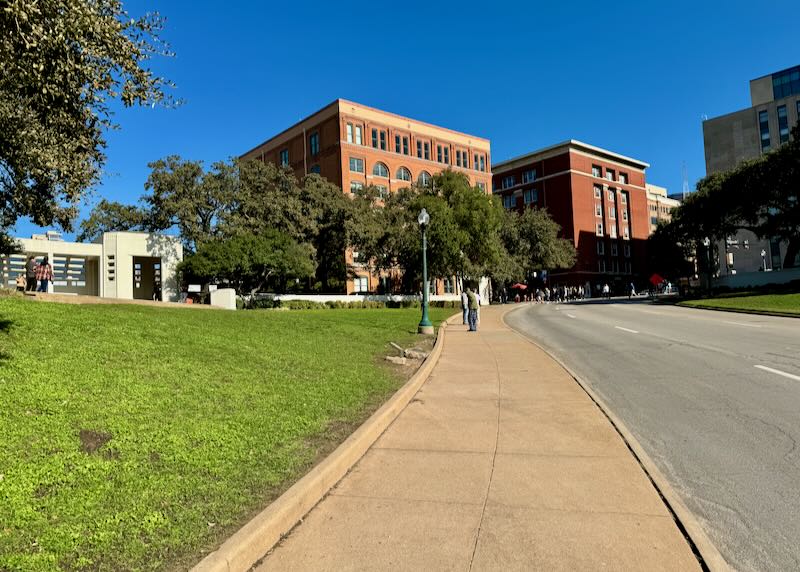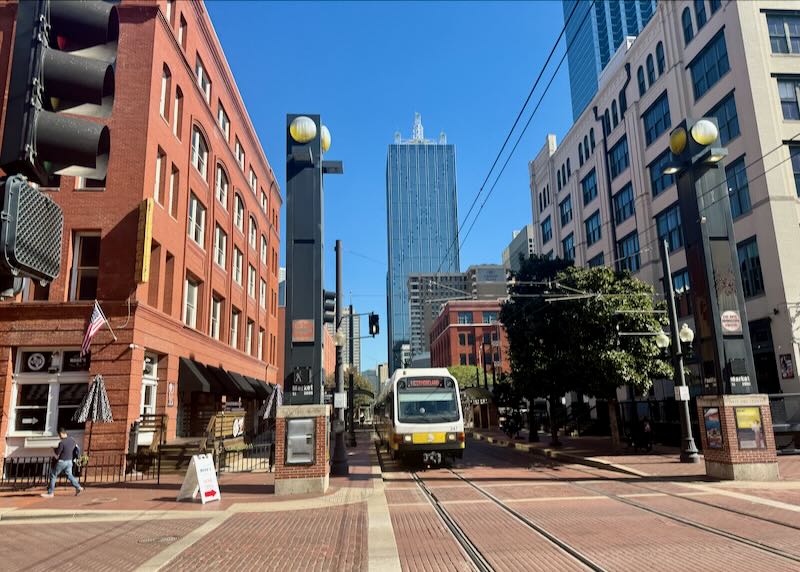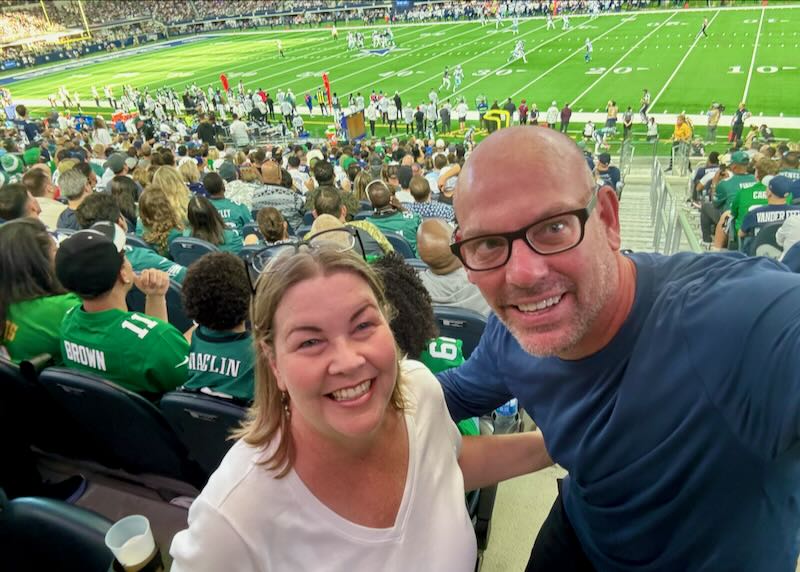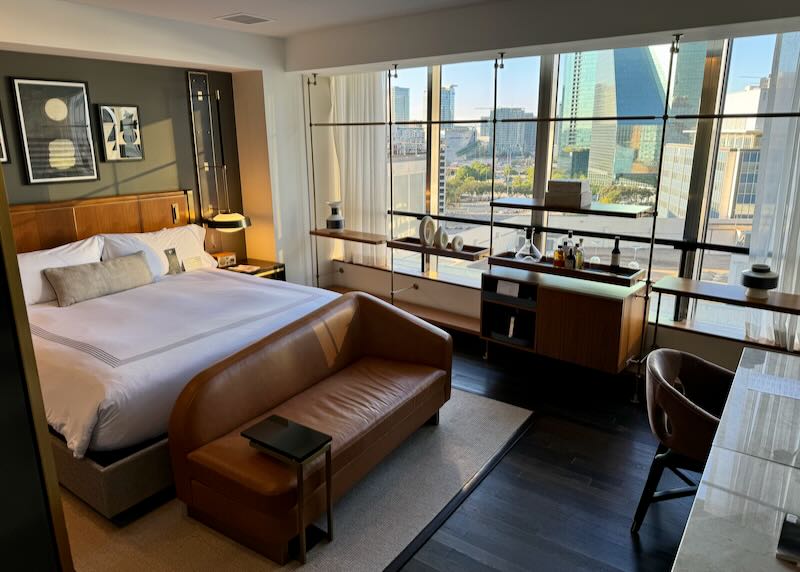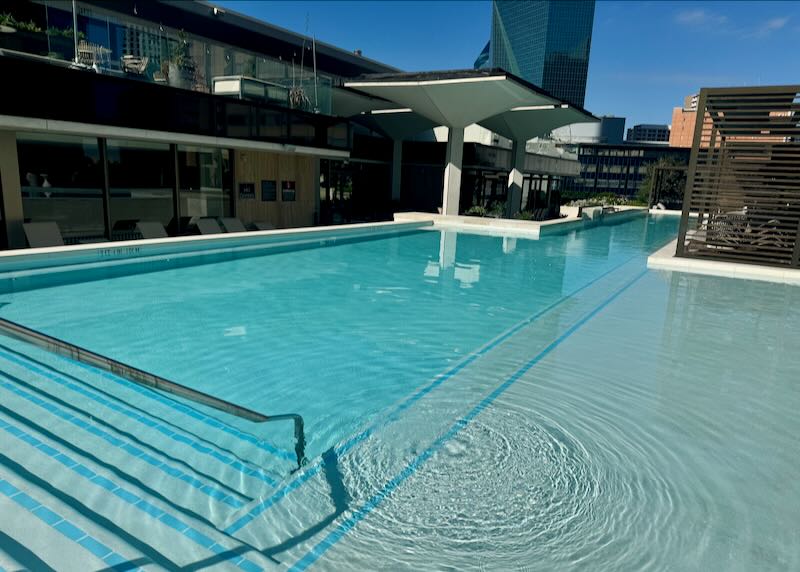By Seattle Dave
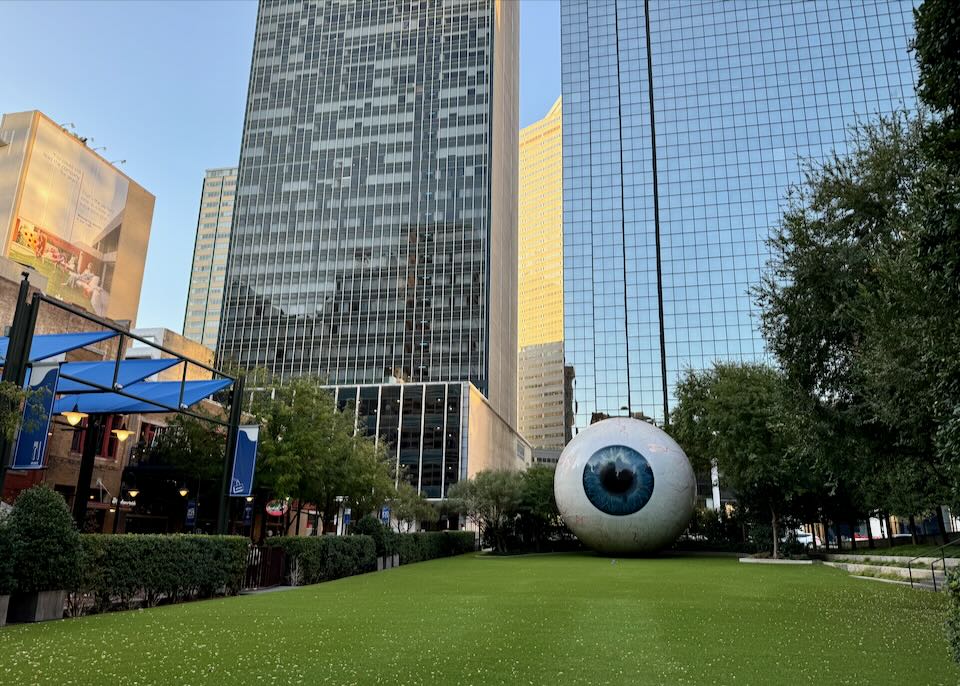
Downtown Dallas on our most recent visit.
Where to Stay in Dallas
Founded in 1841 as a Western trading post, the Dallas–Fort Worth metro area is the fourth largest in the US, with over 7 million people. Though it’s home to several important museums, distinctive neighborhoods, and a thriving culinary and arts scene, the “Big D” remains best known as the site of the assassination of President Kennedy in 1963, as well as the Dallas TV show and the Cowboys football team. But in addition to the important memorials and museums associated with JFK, the city is home to the world-class Dallas Arboretum & Botanical Gardens, George W. Bush Presidential Library and Museum, Dallas Museum of Art, family-friendly Perot Museum of Nature and Science, and a lot more.
The JFK Memorial and Book Depository Museum in downtown Dallas.
Dallas is also filled with great places to stay, and though most options are in attraction-heavy Downtown, it’s worth considering nearby Uptown and the Design District, both with their own sights, nightlife, and dining scenes. The other central neighborhoods of interest to visitors include the Deep Ellum entertainment district and Fair Park, home to the Texas State Fair. Beyond central Dallas, there’s more to see in Park Cities, White Rock Lake, and Arlington, home of the Dallas Cowboys. We’ve also covered neighboring Fort Worth itself, the junior but equally interesting partner in the greater metro area.
While it’s relatively easy to explore the city center on foot, the DART (Dallas Area Rapid Transit) system operates a light rail network that runs through Downtown, numerous outer neighborhoods, and goes as far as Fort Worth (via Trinity Railway Express) and Dallas/Fort Worth airport.
Another convenient option is the free (or at least donation-only) McKinney Trolley, which connects downtown to Uptown and its West Village entertainment area via McKinney Avenue.
• Do you need a car in Dallas? It depends how much you intend to see. Public transportation is pretty good and beyond that, an Uber is always a great option. If your trip is going to be confined to Downtown and Uptown, with perhaps a day trip to central Fort Worth, you probably don’t need car. Needless to say, most locals drive everywhere and the roads are often heavily congested – there’s also a fiendish one-way system and a lot of accidents annually. If you aim to visit attractions further out of the center – the Dallas Arboretum and Botanical Garden, or the George W. Bush Presidential Center for the example – renting a car will likely save you time, but avoid rush hour.
The DART running through downtown Dallas.
• The official Dallas tourist website is a good resource.
• Dallas Fort Worth International Airport is the main regional airport, around 17 miles west of Downtown. Smaller Dallas Love Field, primarily used by Southwest Airlines, is around 6 miles northwest of Downtown.
We’ve covered our favorite neighborhoods to visit and stay in more detail below, but with more time these districts are also worth checking out:
• Park Cities: Some 5 miles northeast from Downtown, the relatively affluent Park Cities area is home of the sprawling Southern Methodist University campus. The two major draws for visitors are the George W. Bush Presidential Center, with its slick museum dedicated to the life and career of the 43rd president, and the Meadows Museum, which holds a cache of exceptional Spanish art from early Renaissance masters to modern works by Pablo Picasso, Joan Miró, and Juan Gris, plus an especially good collection from Goya. Though it’s a little out of the way, there are actually some excellent places to stay here. Our favorite hotels are The Highland, Hilton Park Cities, Lumen, and The Beeman. It’s also worth looking at the nearby Drey Hotel.
• Lake & Garden: Anchored by picturesque White Rock Lake Park, this area, 6 miles northeast from Downtown, makes a pleasant escape from the city grind, with hiking and biking trails, plus all sorts of watersports on the lake available. The main draw for most visitors is the lakeside Dallas Arboretum and Botanical Garden, which boasts 11 lush gardens and the Rory Meyers Children’s Adventure Garden, specially designed to make life and earth sciences more interesting for kids. Also on the lake, the Bath House Cultural Center, home to a theater, art galleries and a small museum. There’s nowhere convenient to stay around the lake, though you may find apartment rentals, and there are some motels along I-30 to the south (and also nearby in Park Cities, see above). Otherwise it’s around 30 minutes by bus from Downtown.
My wife and I at a Dallas Cowboy game in Arlington.
• Arlington: Arlington lies halfway between Fort Worth and Dallas (around 20 miles west of Downtown Dallas). You might want to stay here if your main aim is to see the Dallas Cowboys football team play at AT&T Stadium (or see a concert there). In summer you’ll want to catch a Texas Rangers baseball game at Globe Life Field. WNBA’s Dallas Wings are also based here, at the College Park Center. Six Flags Over Texas, Hurricane Harbor Arlington waterpark, the UTA Planetarium, and the River Legacy Park along the Trinity River (with the River Legacy Living Science Center), makes this a fun place to stay for families. You’ll need car to get around (and to visit Dallas proper).
There’s a huge range of accommodation here, clustered around the I-30 junction with Hwy-360. Our favorite hotels are: Aloft Arlington Entertainment District, Hilton Arlington, Hyatt Place Arlington, Live! by Loews-Arlington, La Quinta Arlington North 6 Flags Drive, the excellent Sanford House, and the Ranger Inn & Suites for bargain rates.
Best Places to Stay in Dallas
Our room at the the Fairmont Hotel. The best located hotel in downtown Dallas.
- Best Luxury Hotels in Dallas
Fairmont • Adolphus • Hotel Crescent Court • Hall Arts Hotel • Hyatt Regency • Omni • Ritz-Carlton • Rosewood Mansion on Turtle Creek- Best Boutique Hotels in Dallas
Drey • Kimpton Pittman • Joule • Lumen • ZaZa Uptown- Best B&Bs in Dallas
Gaston • Sanford House- Best Cheap & Mid-range Hotels in Dallas
Comfort Inn & Suites Medical-Market Center • Magnolia Downtown • SOVA Micro-Room & Social Hotel • Tru Market CenterBest Neighborhoods in Dallas for…
- Best Neighborhood to Stay for First Timers/Sightseeing: Downtown Dallas
Though you might consider the slightly more interesting Uptown (with more expensive hotels) and the Design District (with cheaper hotels), most first-time visitors should aim to stay Downtown. There’s a big choice of accommodation here and plenty of attractions within walking distance, from the JFK-related sights in the West End to the galleries and museums of the Arts District. And though it’s not really the best place to eat or go out, there are plenty of excellent restaurants and bars to choose from.- Best Neighborhoods for Nightlife: Deep Ellum, Lower Grenville and Cedars/Southside
Nightlife is spread out across the metro area, with several neighborhood hubs worth checking out, but Deep Ellum, just east of Downtown, is a solid bet for a good bars and live music venues. The former warehouse district is also crammed with excellent places to eat. Its role as nightlife center goes way back to the early 1900s when it developed as a haven for blues and jazz. Today the tradition is maintained at venues such as Trees, Club Dada, and Adair’s Saloon. Other favorite nightlife haunts here include Louie Louie’s Piano Bar, live venue Sons of Hermann Hall, local bar Three Links, live venue the Bomb Factory, and craft-beer specialist Deep Ellum Brewing Company. That’s just scratching the surface – the area is crammed with hip bars and performing venues (including Dallas Comedy Club). There are only 2 hotels here (though it’s possible to rent apartments), both pretty good: the moderate Home2Suites by Hilton and the upscale Kimpton Pittman.Other nightlife areas to check out include Uptown (where we like the cocktails at Bowen House and the Guinness at Blackfriar Pub), and Lower Greenville, anchored by Greenville Avenue some 4 miles northeast from Downtown. Highlights here include the local beers at the Libertine Bar, the outdoor Truck Yard, Leela’s Wine Bar, Swizzle (a fun tiki bar) and the craft cocktails at HG Sply Co. There are no hotels in Lower Greenville – take a taxi from Downtown or Uptown.
Finally, Cedars/Southside (just south of Downtown) is another popular nightlife hub, home to the rooftop Gallery Lounge, Poor David’s Pub, live venue Southside Ballroom, and many others. Though it’s an easy hop from Downtown, we like the Canvas Hotel here and the Lorenzo Hotel nearby, on the edge of Downtown.
- Best Neighborhoods for Food and Restaurants: Trinity Groves and Uptown
Dallas’s restaurant scene is also extremely diverse and spread out, with several neighborhoods offering excellent options. Downtown is much improved, with the area around AT&T Discovery District and Main Street offering a good selection of restaurants. Deep Ellum is also a great place to eat as well as drink (the barbecue at Pecan Lodge is a city essential, as are the sandwiches at Uncle Uber’s Sammich Shop) while dedicated foodies should aim to explore Lower Greenville Avenue, home to lauded spots such as Son of a Butcher and Ngon Vietnamese Kitchen.Our overall favorite currently is Trinity Groves, tucked away across the Margaret Hunt Hill Bridge, on the west side of the Trinity River from Downtown. Highlights here include Tex-Mex specialist Beto & Son, Saint Rocco’s NYC-style Italian and the sweet treats at Kate Weiser Chocolate and Cake Bar. There are no hotels here as yet, but it’s an easy hop from Downtown.
Our other top area for foodies – with plenty of hotels this time – is Uptown. Some of the city’s best-known chefs have restaurants here: Kent Rathbun’s Imoto, the “Father of Southwestern Cuisine” Dean Fearling’s restaurant at the Ritz-Carlton, and Pastry Chef Andrea Meyer’s Bisous Bisous Pâtisserie. There’s plenty of other choices, from the Lebanese and Moroccan food at Baboush, Japanese hotspot Uchi, and old school S&D Oyster Company, to local chain Hopdoddy Burger Bar and Thai/Vietnamese spot Malai Kitchen. Henry’s Majestic is the place for brunch, while local celebs like to eat at Nick & Sam’s Steakhouse.
Head to a branch of Babe’s Chicken Dinner House in the outer suburbs to sample locally beloved fried chicken dishes.
- Best Neighborhood for Shopping: Downtown Dallas, Uptown and Design District
Dallas is the home of iconic department store Neiman Marcus, founded in 1907. It’s flagship remains Downtown, at the corner of Main and Ervay streets. Nearby are luxury boutiques Forty Five Ten and Traffic Los Angeles, while the West End is home to local icon Wild Bill’s Western Store. Uptown’s West Village is another walkable shopping district, with around 100 specialty boutiques in addition to the usual big box retailers. Dallas-based menswear specialist Mizzen + Main has its flagship here, while Nicole Kwon is an upscale women’s boutique. Branches of Q Clothier, Rye 51, and y&i clothing boutique are also Uptown.Anyone interested in contemporary art, antiques, or upscale interior design should check out the Design District, home to Lula B’s Antique Mall and numerous art galleries.
- Best Neighborhood for Local Vibe: Bishop Arts District (Oak Cliff)
Some three miles southwest of Downtown, the Bishop Arts District is a 2-block former warehouse sub-neighborhood of Oak Cliff, home to hip boutiques, restaurants, bars, coffee shops, and galleries. It’s a fun area to explore on foot, with highlights including the Latin American art at the Mercado369 gallery, live music at the Kessler, Salvadoran food at Gloria’s Latin Cuisine, Zen Sushi, and the delicious doughnuts at The Salty. We also love the coffee at Brewed Ltd. For a real treat visit the Dallas Grilled Cheese Co or Emporium Pies. You can also shop for unique gifts at Fete-ish, Urban Owl, and We Are 1976, or peruse Poets Oak Cliff Bookshop. To the south on Jefferson Boulevard, you can watch movies at the Texas Theatre, best known for being the location of Lee Harvey Oswald’s arrest in 1963. Staying here usually means apartments rather than hotels, though Bishop Arts Hotel is an excellent option.- Best LBGTQ Neighborhood: Oak Lawn
Anchored by Cedar Springs Road just north of Uptown, Oak Lawn is home to Dallas’ LGBTQ community. The annual Dallas Pride festival takes place at Fair Park (in June), but Oak Lawn is always swinging at this time, while the Halloween Block Party takes place along Cedar Springs Road in October. The neighborhood is crammed with LGBT-friendly bars and clubs year-round, like JR’s Bar & Grill, Station 4, Sue Ellen’s (one of the only lesbian clubs in the country), and Woody’s. The place to stay here is the Warwick Melrose. Rosewood Mansion on Turtle Creek is also close by.- Unsafe Areas of Dallas
Central Dallas is generally quite safe (and crime rates overall have been falling), though the usual precautions should be taken at night. Areas of South Dallas such as South Boulevard/Park Row and Cedar Crest post high crime rates, but you are unlikely to end up in these neighborhoods.The 5 Best Neighborhoods in Dallas for Tourists
1. Downtown Dallas
Skyscraper-studded Downtown Dallas is the commercial and historic heart of the city, filled with attractions and places to stay. Though it lacks the character of some of the outer neighborhoods, it’s become a lot more tourist-friendly in recent years, despite the daily tide of commuters (who traditionally have rapidly vacated the area after work), and features plenty of parks, places to eat, and nightlife. To get a birds-eye view of the city, visit the observation deck at Reunion Tower. The West End District is where you’ll find JFK Memorial Plaza, The Sixth Floor Museum at Dealey Plaza, and the iconic “grassy knoll” associated with the Kennedy assassination, as well as the Old Red Museum, newly housed in 3 County buildings: Old Red, the Criminal Courts/Records Building Complex, and the Schoolbook Depository. Also nearby are the Dallas Holocaust and Human Rights Museum and the kid-friendly Dallas World Aquarium.
The 20 square-block Arts District lies on the northern edge of downtown, a walkable neighborhood anchored by the excellent Dallas Museum of Art and Nasher Sculpture Center, plus a host of major cultural institutions: the AT&T Performing Arts Center Complex and Winspear Opera House, the Dallas Symphony Orchestra, and Dallas Chamber Symphony among them. There’s also the smaller Crow Museum of Asian Art, with rare works from China, Tibet, Cambodia, and India. Nearby, the Perot Museum of Nature and Science is a big draw for families. On the south side of Downtown lies the daily Dallas Farmers Market and Pioneer Plaza, which features 49 bronze longhorn cattle sculptures, herded by 3 bronze cowboys. One of the newer micro-neighborhoods Downtown is the AT&T Discovery District, home to restaurants and bars.
The rooftop pool at the Fairmont Hotel.
- Best Hotels:
Fairmont • Adolphus • Mint House Dallas • Hall Arts Hotel • Hyatt Regency • Joule • Omni- Best Cheap/Midrange Hotels:
Magnolia Downtown • SOVA Micro-Room & Social Hotel2. Uptown
Just north of Downtown (connected to the Arts District by Klyde Warren Park), Uptown is a dynamic district in its own right, home to some of the city’s best hotels, shops, and restaurants. It offers a little more character than Downtown, though the hotels tend to be on the pricier side – if you can afford it, it’s a great place to stay, with the main drag McKinney Avenue traversed by the convenient (and free) vintage trolley service. In terms of sights, there’s the unique Samurai Collection at the Ann & Gabriel Barbier-Mueller Museum and unusual Museum of Geometric and MADI Art, dedicated to the abstract art movement founded in 1940s Buenos Aires. Adjacent Victory Park is home to the American Airlines Center, base of the NBA’s Dallas Mavericks and hockey’s Dallas Stars.
But Uptown is primarily known for its eating, drinking, and shopping scenes. To the north, the area known as Knox/Henderson (named after the 2 streets) is a popular entertainment hub, while the West Village spans McKinney Avenue at the heart of Uptown. Uptown also boasts its own performing arts scene, anchored by venues such as the Frank Lloyd Wright-designed Kalita Humphreys Theater and Uptown Players, plus Theatre Three.
- Best Hotels:
Canopy Uptown • Hotel Crescent Court • Marriott Uptown • Le Méridien The Stoneleigh • Ritz-Carlton • ZaZa Uptown • W Dallas – Victory3. Design District
A couple of miles northwest of Downtown, the formerly industrial Design District is a burgeoning neighborhood of antique stores, numerous art galleries, and high-end interior design showrooms. It also features a growing number of dining options and craft breweries, making it an intriguing alternative to Downtown when it comes to accommodation, especially if this isn’t your first visit to Dallas (or you are interested in perusing art galleries – there are a lot here). Highlights include the Dallas Contemporary gallery and the Haas Moto Museum & Sculpture Gallery, which displays 230 motorcycles spanning 13 decades. Families might enjoy the Medieval Times Dinner & Tournament, while the Dallas Market Center is a vast trade exhibition complex. We also enjoy the craft beers at Peticolas Brewing Company, and breakfast at the local outpost of Mama’s Daughters’ Diner.
- You’ll find a lot more cheaper hotels and motels along I-35E north of the district proper – it’s the cheapest place to stay near Downtown Dallas.
- Best Hotels:
Courtyard Medical/Market Center • Marriott Suites Medical/Market Center • Hilton Anatole • Homewood Suites Market Center • Renaissance • Virgin Hotels- Best Cheap/Midrange Hotels:
Comfort Inn & Suites Medical-Market Center • Hampton Inn & Suites Market Center • Hilton Garden Inn Market Center • Tru Market Center4. Fair Park
Two miles or so east from Downtown, Fair Park is best known as the home of the annual State Fair of Texas (Sept–Oct), but there are plenty of attractions here year-round. Unusually, the park features the world’s largest collection of Art Deco exhibition buildings, created in 1936 for the Texas Centennial Exposition. Highlights include the African American Museum of Dallas with an especially good folk art collection, the Dallas Historical Society and awe-inspiring Hall of State Building (adorned with murals representing Texas history), the Children’s Aquarium, and the educational Texas Discovery Gardens. The Music Hall at Fair Park, Dos Equis Pavilion, and Margo Jones Theatre host shows and musicals. On the northwestern edge of the park lies the enlightening Dallas Firefighters Museum.
- Surprisingly, there are no hotels in or around Fair Park – it’s a short metro train ride from Downtown.
5. Fort Worth
Though it’s a separate city some 30 miles west of Downtown Dallas, we’ve included Fort Worth here as a key component of the greater metro area – most visitors spend time in both cities on the same trip. Though it’s long been in Dallas’s shadow, Fort Worth does boast plenty of its own attractions. Downtown is anchored by Sundance Square, a pedestrian-friendly district of shops, restaurants, and bars. Highlights include the stunning Bass Performance Hall, the Sid Richardson Museum of Western Art, and the nearby Fort Worth Water Gardens, designed by star architect Phillip Johnson.
Fort Worth’s premier attractions, though, lie in the Cultural District, 2 miles west of downtown. Here you’ll find the world-class Kimbell Art Museum, showing everything from pre-Columbian to African art; the stylishly designed Modern Art Museum of Fort Worth, which contains a huge collection of modern art; and the Amon Carter Museum of American Art, among many other museums. The other key attraction in Fort Worth is the historic 10-block Stockyards area, anchored by Exchange Avenue 2 miles north of Downtown. There are daily cattle drives of Texas Longhorns; Billy Bob’s Texas, the world’s largest honky-tonk; John Wayne: An American Experience, dedicated to the iconic movie star; Stockyards Museum, and the Texas Cowboy Hall of Fame.
- Fort Worth’s public transport system is operated by Trinity Metro, with buses linking all the main tourist areas and the Trinity Railway Express running a convenient service to Dallas.
- For more information visit the official website.
- Best Hotels:
Aloft Fort Worth Downtown • Ashton Hotel • Embassy Suites Fort Worth Downtown • Hampton Inn & Suites Fort Worth Downtown • Homewood Suites Fort Worth Medical Center • Kimpton Harper • Omni Fort Worth • Sinclair • Worthington Renaissance Fort Worth- Best Cheap/Midrange Hotels:
Courtyard Fort Worth Downtown/Blackstone • Fairfield Inn & Suites Fort Worth Downtown/Convention Center • Home2 Suites Fort Worth Cultural District- Best B&B:
Three Danes Inn
